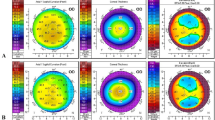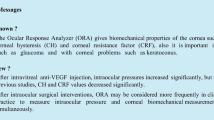Abstract
Purpose
To evaluate the intraocular pressure (IOP) trend and risk factors for IOP rise after myopic photorefractive keratectomy (PRK).
Patients and methods
One eye of each patient undergone PRK for myopia was randomly assigned to this study. All eyes underwent tonometry by CorVis Scheimpflug Technology (CST) tonometer (Oculus Optikgeräte GmbH, Wetzlar, Germany) 1 week, 2 weeks, 1 month, 2 months, 3 months and 4 months after surgery. The eyes with IOP rise more than 5 mmHg and the risk factors were evaluated by Kaplan–Meier graph and multiple Cox regression analysis.
Results
A total of 348 eyes of 348 patients were enrolled in this study. Forty-three eyes (12.35%) experienced a steroid-induced IOP rise of more than 5 mmHg. Eyes with IOP rise had higher baseline IOP (Median 19 mmHg (IQR 18–22) versus Median 15 mmHg (IQR 14–16); p < 0.001). Baseline central corneal thickness (CCT) was higher in eyes without IOP rise (Median 520 µm (IQR 509–541) versus Median 535 µm (IQR 518–547); p = 0.009). In multivariate Cox regression analysis, higher baseline IOP was a risk factor for IOP rise (Hazard Ratio (HR) 1.59 (95% CI 1.43–1.77); p < 0.001) while higher baseline CCT was protective (HR 0.97 (95% CI 0.95–0.98); p < 0.001).
Conclusion
Eyes with higher baseline IOP and lower baseline CCT are at increased risk of IOP rise after PRK and should be monitored more frequently.

Similar content being viewed by others
Availability of data and material
The data that support the findings of this study are available from the corresponding author, [SMT], upon reasonable request.
References
Morgan IG, Ohno-Matsui K, Saw S-M (2012) Myopia. The Lancet 379(9827):1739–1748
Vitale S, Sperduto RD, Ferris FL (2009) Increased prevalence of myopia in the United States between 1971–1972 and 1999–2004. Arch Ophthalmol 127(12):1632–1639
Holden BA, Fricke TR, Wilson DA, Jong M, Naidoo KS, Sankaridurg P et al (2016) Global prevalence of myopia and high myopia and temporal trends from 2000 through 2050. Ophthalmology 123(5):1036–1042
Vestergaard AH (2014). Past and present of corneal refractive surgery: a retrospective study of long-term results after photorefractive keratectomy and a prospective study of refractive lenticule extraction. Acta Ophthalmol (Copenh). 92 Thesis 2:1–21.
Gokhale NS (2013) Epidemiology of keratoconus. Indian J Ophthalmol 61(8):382–383
Marques EF, Leite EB, Cunha-Vaz JG (1995). Corticosteroids for reversal of myopic regression after photorefractive keratectomy. J Refract Surg Thorofare NJ 1995. 11(3 Suppl):S302–308.
Marcus MW, de Vries MM, Junoy Montolio FG, Jansonius NM (2011) Myopia as a risk factor for open-angle glaucoma: a systematic review and meta-analysis. Ophthalmology 118(10):1989-1994.e2
Schmack I, Dawson DG, McCarey BE, Waring GO, Grossniklaus HE, Edelhauser HF (2005) Cohesive tensile strength of human LASIK wounds with histologic, ultrastructural, and clinical correlations. J Refract Surg Thorofare NJ 1995. 21(5):433–45.
Shen Y, Zhao J, Yao P, Miao H, Niu L, Wang X et al (2014) Changes in corneal deformation parameters after lenticule creation and extraction during small incision lenticule extraction (SMILE) procedure. PLoS ONE 9(8):e103893
Schallhorn JM, Schallhorn SC, Ou Y (2015) Factors that influence intraocular pressure changes after myopic and hyperopic LASIK and photorefractive keratectomy: a large population study. Ophthalmology 122(3):471–479
Uzbek AK, Kamburoğlu G, Mahmoud AM, Roberts CJ (2011) Change in biomechanical parameters after flap creation using the intralase femtosecond laser and subsequent excimer laser ablation. Curr Eye Res 36(7):614–619
De Bernardo M, Cembalo G, Rosa N (2020) Reliability of intraocular pressure measurement by goldmann applanation tonometry after refractive surgery: a review of different correction formulas. Clin Ophthalmol Auckl NZ 14:2783–2788
Brandt JD, Gordon MO, Gao F, Beiser JA, Miller JP, Kass MA et al (2012) Adjusting intraocular pressure for central corneal thickness does not improve prediction models for primary open-angle glaucoma. Ophthalmology 119(3):437–442
Lee H, Roberts CJ, Kim T-I, Ambrósio R, Elsheikh A, Yong Kang DS (2017) Changes in biomechanically corrected intraocular pressure and dynamic corneal response parameters before and after transepithelial photorefractive keratectomy and femtosecond laser-assisted laser in situ keratomileusis. J Cataract Refract Surg 43(12):1495–1503
Hugo J, Granget E, Ho Wang Yin G, Sampo M, Hoffart L (2018) Intraocular pressure measurements and corneal biomechanical properties using a dynamic Scheimpflug analyzer, after several keratoplasty techniques, versus normal eyes. J Fr Ophtalmol 41(1):30–38
Razeghinejad MR, Katz LJ (2012) Steroid-induced iatrogenic glaucoma. Ophthalmic Res 47(2):66–80
Shousha SM, Steit MAA, Hosny MH, Ewais WA, Shalaby AM (2013) Comparison of different intraocular pressure measurement techniques in normal eyes, post surface and post lamellar refractive surgery. Clin Ophthalmol Auckl NZ 7:71
Armaly MF (1963). Effect of corticosteroids on intraocular pressure and fluid dynamics. II. The effect of dexamethasone in the glaucomatous eye. Arch Ophthalmol Chic Ill 1960. 70:492–9.
Urban RC, Dreyer EB (1993) Corticosteroid-induced glaucoma. Int Ophthalmol Clin 33(2):135–139
Pleyer U, Ursell PG, Rama P (2013) Intraocular pressure effects of common topical steroids for post-cataract inflammation: are they all the same? Ophthalmol Ther 2(2):55–72
Javadi M-A, Mirbabaei-Ghafghazi F, Mirzade M, Yazdani S, Yaseri M (2008) Steroid induced ocular hypertension following myopic photorefractive keratectomy. J Ophthalmic Vis Res 3(1):42
Yamamoto Y, Komatsu T, Koura Y, Nishino K, Fukushima A, Ueno H (2008) Intraocular pressure elevation after intravitreal or posterior sub-Tenon triamcinolone acetonide injection. Can J Ophthalmol 43(1):42–47
Busool Y, Mimouni M, Vainer I, Levartovsky S, Sela T, Munzer G et al (2017) Risk factors predicting steroid-induced ocular hypertension after photorefractive keratectomy. J Cataract Refract Surg 43(3):389–393
Lau L-I, Chen K-C, Lee F-L, Chen S-J, Ko Y-C, Liu CJ-L et al (2008) Intraocular pressure elevation after intravitreal triamcinolone acetonide injection in a Chinese population. Am J Ophthalmol 146(4):573–578
Lam DSC, Fan DSP, Ng JSK, Yu CBO, Wong CY, Cheung AYK (2005) Ocular hypertensive and anti-inflammatory responses to different dosages of topical dexamethasone in children: a randomized trial. Clin Experiment Ophthalmol 33(3):252–258
Garbe E, LeLorier J, Boivin JF, Suissa S (1997) Risk of ocular hypertension or open-angle glaucoma in elderly patients on oral glucocorticoids. Lancet Lond Engl 350(9083):979–982
Friedman DS, Holbrook JT, Ansari H, Alexander J, Burke A, Reed SB et al (2013) Risk of elevated intraocular pressure and glaucoma in patients with uveitis: results of the multicenter uveitis steroid treatment trial. Ophthalmology 120(8):1571–1579
Parekh A, Srivastava S, Bena J, Albini T, Nguyen QD, Goldstein DA (2015) Risk factors associated with intraocular pressure increase in patients with uveitis treated with the fluocinolone acetonide implant. JAMA Ophthalmol 133(5):568–573
Leske MC, Connell AM, Wu SY, Hyman LG, Schachat AP (1995). Risk factors for open-angle glaucoma. The Barbados Eye Study. Arch Ophthalmol Chic Ill 1960. 113(7):918–24.
Chihara E, Liu X, Dong J, Takashima Y, Akimoto M, Hangai M et al (1997) Severe myopia as a risk factor for progressive visual field loss in primary open-angle glaucoma. Ophthalmol J Int Ophtalmol Int J Ophthalmol Z Augenheilkd 211(2):66–71
Mitchell P, Hourihan F, Sandbach J, Wang JJ (1999) The relationship between glaucoma and myopia: the blue mountains eye study. Ophthalmology 106(10):2010–2015
Xu L, Wang Y, Wang S, Wang Y, Jonas JB (2007) High myopia and glaucoma susceptibility the Beijing Eye study. Ophthalmology 114(2):216–220
Chang DF, Tan JJ, Tripodis Y (2011) Risk factors for steroid response among cataract patients. J Cataract Refract Surg 37(4):675–681
Gordon MO, Beiser JA, Brandt JD, Heuer DK, Higginbotham EJ, Johnson CA et al (2002) The ocular hypertension treatment study: baseline factors that predict the onset of primary open-angle glaucoma. Arch Ophthalmol 120(6):714–720
Leske MC, Heijl A, Hussein M, Bengtsson B, Hyman L, Komaroff E (2003) Factors for glaucoma progression and the effect of treatment: the early manifest glaucoma trial. Arch Ophthalmol 121(1):48–56
Kanellopoulos AJ, Cruz EM, Ang RET, Asimellis G (2016) Higher incidence of steroid-induced ocular hypertension in keratoconus. Eye Vis 3(1):4
Rhee DJ, Peck RE, Belmont J, Martidis A, Liu M, Chang J et al (2006) Intraocular pressure alterations following intravitreal triamcinolone acetonide. Br J Ophthalmol 90(8):999–1003
Smithen LM, Ober MD, Maranan L, Spaide RF (2004) Intravitreal triamcinolone acetonide and intraocular pressure. Am J Ophthalmol 138(5):740–743
Funding
The authors received no financial support for the research, authorship, and/or publication of this article.
Author information
Authors and Affiliations
Corresponding author
Ethics declarations
Conflict of interest
Ghasem Fakhraie declares that he has no conflict of interest. Zakieh Vahedian declares that she has no conflict of interest. Reza Zarei declares that he has no conflict of interest. Yadollah Eslami declares that he has no conflict of interest. Seyed Mehdi Tabatabaei declares that he has no conflict of interest. Abdollah Hadi declares that he has no conflict of interest. Sepideh Ghods declares that she has no conflict of interest. Ali Fakhraie declares that he has no conflict of interest.
Ethics approval
All procedures performed in this study which involve human participants were in accordance with the ethical standards of the institutional and/or national research committee and with the 1964 Helsinki declaration and its later amendments or comparable ethical standards.
Consent to participate
Informed consent was obtained from all individual participants included in the study.
Consent for publication
There is no identifying information about participants available in the article, so this issue is not applicable.
Additional information
Publisher's Note
Springer Nature remains neutral with regard to jurisdictional claims in published maps and institutional affiliations.
Rights and permissions
About this article
Cite this article
Fakhraie, G., Vahedian, Z., Zarei, R. et al. Intraocular pressure trend following myopic photorefractive keratectomy. Int Ophthalmol 42, 2313–2321 (2022). https://doi.org/10.1007/s10792-022-02228-2
Received:
Accepted:
Published:
Issue Date:
DOI: https://doi.org/10.1007/s10792-022-02228-2




